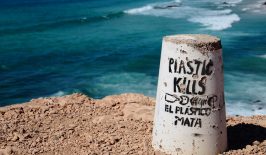Italian architect and furniture designer Gianpiero Tessitore was looking for a more sustainable alternative to traditional upholstery materials such as animal or artificial leather (that’s often finished with a plastic coating). Working together with the University of Florence and other research centres, he began analysing the characteristics of various plant fibres. After much scientific experimentation, Francesco Merlino, environmental technician at the University of Florence and now Tessitore’s business partner, discovered that grape pomace is ideal for producing a textile very similar to leather. Tessitore patented the production process in 2016 and founded the company Vegea, which has dedicated itself to researching and producing sustainable materials from biopolymers for the textile industry ever since.
No poisonous chemicals, no wasted water, no animals harmed
Vegea’s “wine leather” doesn’t only just feel like conventional leather and have similar properties, it has a whole load of other advantages too. Firstly, it doesn’t need any water to produce it – unlike conventional leather which has a huge water footprint. And wine leather doesn’t require a complex and toxic tanning process. The tanning and other treatment processes associated with animal leather involve using huge amounts of poisonous chemicals and heavy metals. While vegetable tanning alternatives are far gentler to the environment, they are much more expensive, meaning the majority of traditional leather is still tanned using chromium. And because leather is often imported from low-resource countries with unsafe working conditions, many leather workers are constantly exposed to toxic chemicals, seriously damaging their health.
The fact this “wine leather” is completely vegetable is another positive aspect. While leather is often a by-product of the meat industry, the argument exists that the existence of the leather industry actually supports factory farming. However, not every animal that ends up as a handbag gets eaten of course. Exotic animals like snakes and crocodiles are often bred and killed specifically for their skin.
“What do I think? I think that separation and enhancement of the by-products of the winery industry, such as skins and seeds are important imperatives for sustainability,” said Gianpiero Tessitore in an interview with LTEconomy.
“VEGEA’s process transforms what represents waste (a cost) in one sector, into a value-added raw material in another sector. And we do it without using toxic pollutants, without any waste of water. That means doing ‘circular economy’!”

Vegea’s wine leather isn’t just suited for the fashion industry – for making clothes, shoes and bags and accessories. It could also be used for upholstery and car seat covers. They’re already working with different textile companies to develop various kinds of materials of different weights, strengths, elasticity levels, finishes and textures. The company presented its first fashion collection last autumn, with clothing, handbags and shoes developed under the creative direction of eco-designer Tiziano Guardini. And Vegea is already looking beyond its wine leather invention too: backed by sponsorship from the EU, the company has returned to the lab and is trying to come up with other ways of sustainably transforming agricultural biomass waste into other useful products and bringing them back into the value chain.
Want to know more about the circular economy? Click here to find out what it means and why it might be the key to a futureproof, sustainable economy.
This is a translation by Marisa Pettit of an original article which first appeared on RESET’s German-language site.






